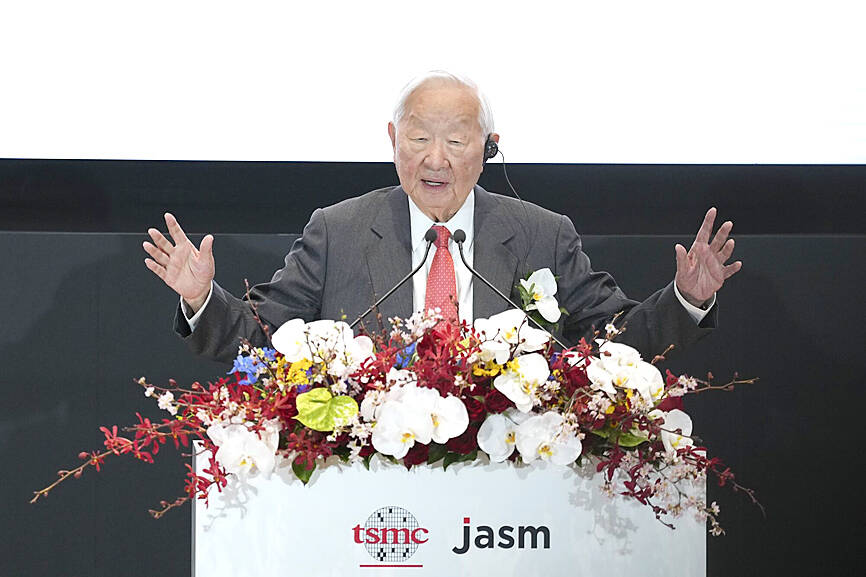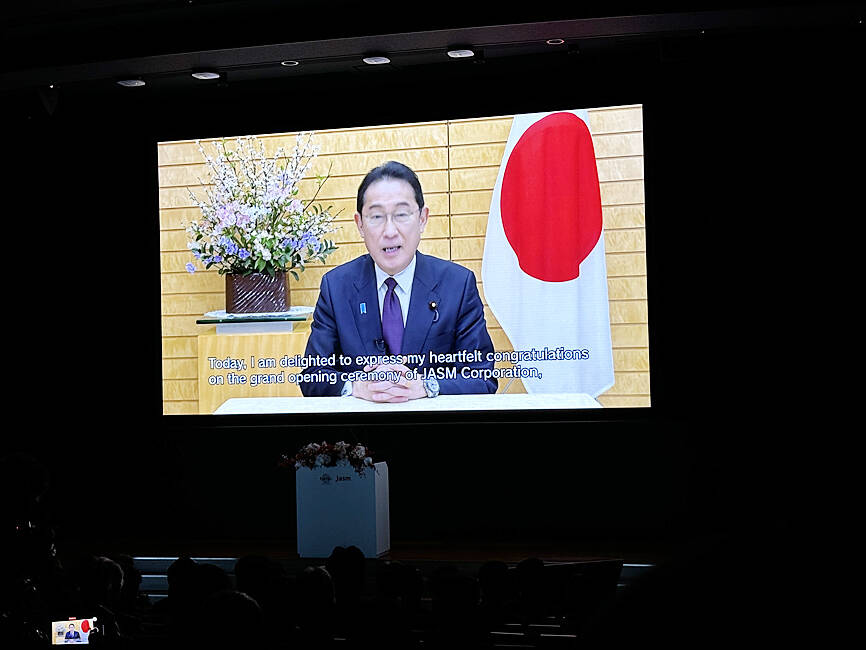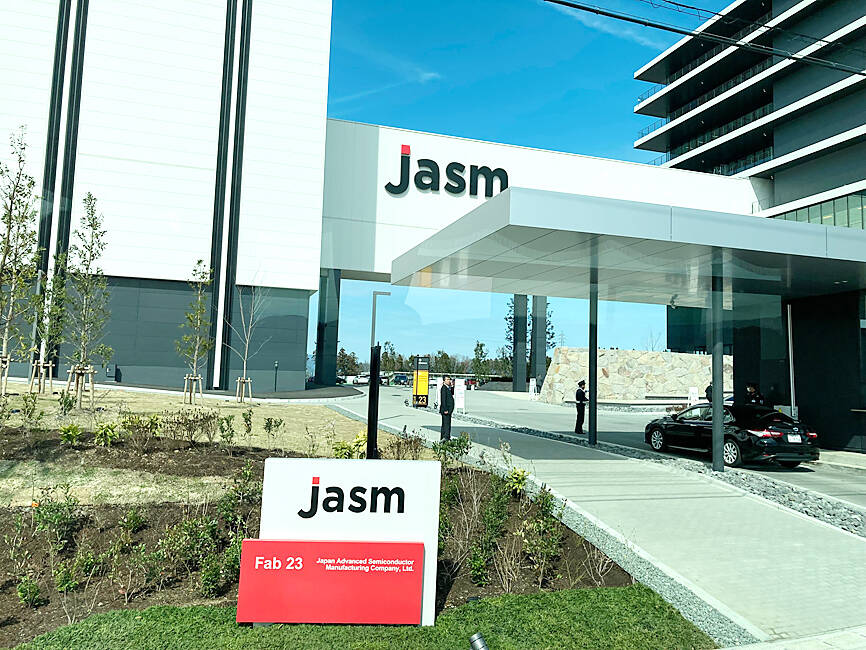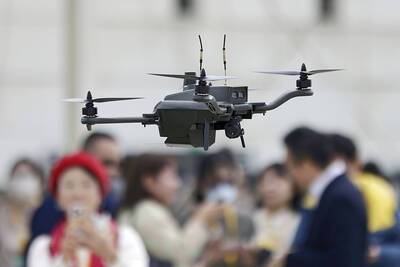Taiwan Semiconductor Manufacturing Co (TSMC, 台積電) yesterday held an opening ceremony for its first chip manufacturing fab in Kumamoto, Japan, which it hopes will improve chip supply resilience and help Japan usher in a semiconductor renaissance.
The Kumamoto fab is slated to enter volume production in the fourth quarter of this year.
The Japanese government said it would extend its financial support of the project to include the construction of a second factory, as TSMC’s investment is crucial to its efforts to revive its semiconductor industry.

Photo: Bloomberg
The Kumamoto fab is owned by a joint venture, Japan Advanced Semiconductor Manufacturing Inc (JASM), which is majority-owned by TSMC. Other partners include Sony Corp and Denso Corp. Toyota Motor Corp joined the venture early this month.
The second fab would use cutting-edge 6-nanometer technology to produce advanced chips to meet growing demand for artificial intelligence (AI) chips, and those used in autonomous vehicles.
“The production of advanced logic semiconductors at JASM is a significant step in both our country’s semiconductor industry and user industries,” Japanese Prime Minister Fumio Kishida said in a prerecorded video during the opening ceremony.

Photo: CNA
The Japanese government has implemented unprecedented support for the development of a domestic manufacturing base for advanced semiconductors, Kishida said.
“As a government, based on the Domestic Investment Promotion Package formulated in December last year, we will continue to swiftly implement support measures such as budget, tax system and regulatory reform,” Kishida said.
The Japanese government has said that it plans to offer about ¥1.2 trillion (US$7.97 billion) in subsidies for the two Kumamoto fabs.

Photo: Lisa Wang, Taipei Times
The construction of the Kumamoto factory went surprisingly well, as it took only one-and-a-half years rather than the 10 years it usually takes for a ¥1 trillion project like this one, Kumamoto Prefecture Governor Ikuo Kabashima said during the ceremony.
During a speech, TSMC founder Morris Chang (張忠謀) said the event reminded him of his first trip to Japan 56 years ago, while he was serving as an integrated circuits executive at Texas Instruments Inc.
He was there in 1968 to talk with Sony cofounder Akio Morita about starting a joint venture, Chang said.
Morita told him he would be pleasantly surprised about the yield he would achieve in Japan, he said.
That prediction came true, and at its height, Texas Instruments operated three semiconductor factories in Japan, he said.
Fifty years after his conversation with Morita, he is again waiting to see if he “will be pleasantly surprised by the yield,” Chang said.
It would be harder this time, because TSMC has a good yield in Taiwan, but he still has high hopes for JASM, he said.
The new JASM fab would “improve the resilience of the chip supply for Japan and for the world,” Chang said. “It will also, I hope and I believe, start a renaissance of semiconductor manufacturing in Japan.”
Semiconductors will be “very much-needed in the future,” driven by demand for AI applications, he said.
AI chip demand would be enormous, requiring tens of thousands wafers and 10 fabs, he said.

The combined effect of the monsoon, the outer rim of Typhoon Fengshen and a low-pressure system is expected to bring significant rainfall this week to various parts of the nation, the Central Weather Administration (CWA) said. The heaviest rain is expected to occur today and tomorrow, with torrential rain expected in Keelung’s north coast, Yilan and the mountainous regions of Taipei and New Taipei City, the CWA said. Rivers could rise rapidly, and residents should stay away from riverbanks and avoid going to the mountains or engaging in water activities, it said. Scattered showers are expected today in central and

COOPERATION: Taiwan is aligning closely with US strategic objectives on various matters, including China’s rare earths restrictions, the Ministry of Foreign Affairs said Taiwan could deal with China’s tightened export controls on rare earth metals by turning to “urban mining,” a researcher said yesterday. Rare earth metals, which are used in semiconductors and other electronic components, could be recovered from industrial or electronic waste to reduce reliance on imports, National Cheng Kung University Department of Resources Engineering professor Lee Cheng-han (李政翰) said. Despite their name, rare earth elements are not actually rare — their abundance in the Earth’s crust is relatively high, but they are dispersed, making extraction and refining energy-intensive and environmentally damaging, he said, adding that many countries have opted to

SUPPLY CHAIN: Taiwan’s advantages in the drone industry include rapid production capacity that is independent of Chinese-made parts, the economic ministry said The Executive Yuan yesterday approved plans to invest NT$44.2 billion (US$1.44 billion) into domestic production of uncrewed aerial vehicles over the next six years, bringing Taiwan’s output value to more than NT$40 billion by 2030 and making the nation Asia’s democratic hub for the drone supply chain. The proposed budget has NT$33.8 billion in new allocations and NT$10.43 billion in existing funds, the Ministry of Economic Affairs said. Under the new development program, the public sector would purchase nearly 100,000 drones, of which 50,898 would be for civil and government use, while 48,750 would be for national defense, it said. The Ministry of

UNITED: The other candidates congratulated Cheng on her win, saying they hoped the new chair could bring the party to victory in the elections next year and in 2028 Former Chinese Nationalist Party (KMT) lawmaker Cheng Li-wun (鄭麗文) yesterday won the party’s chair election with 65,122 votes, or 50.15 percent of the votes. It was the first time Cheng, 55, ran for the top KMT post, and she is the second woman to hold the post of chair, following Hung Hsiu-chu (洪秀柱), who served from 2016 to 2017. Cheng is to succeed incumbent Eric Chu (朱立倫) on Nov. 1 for a four-year term. Cheng said she has spoken with the other five candidates and pledged to maintain party unity, adding that the party would aim to win the elections next year and